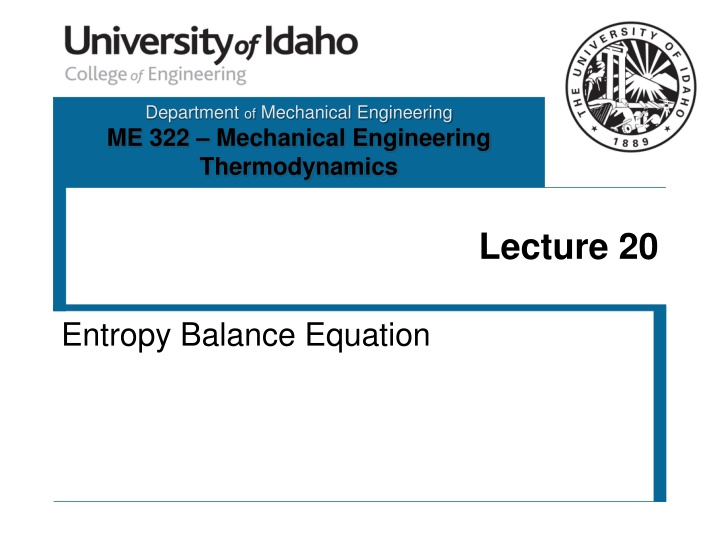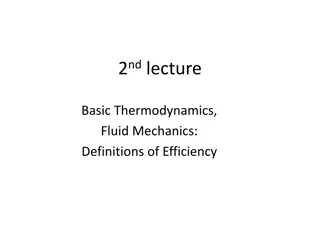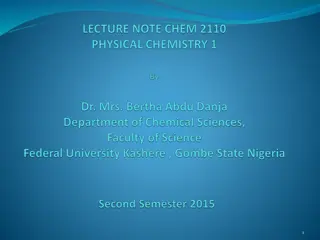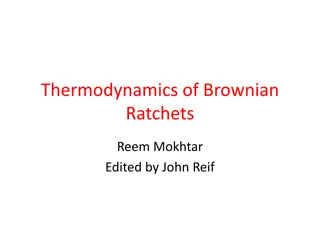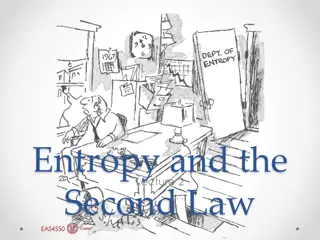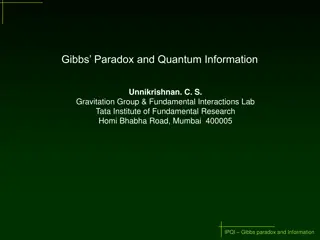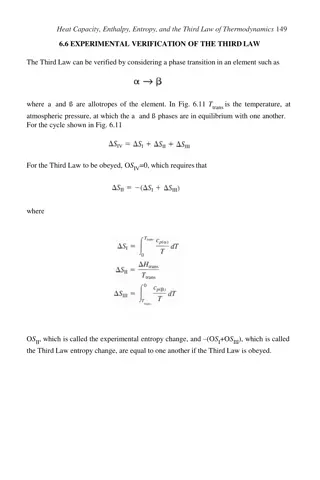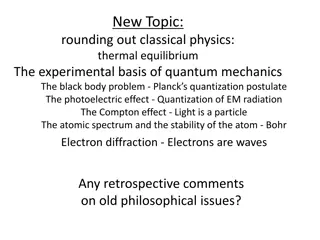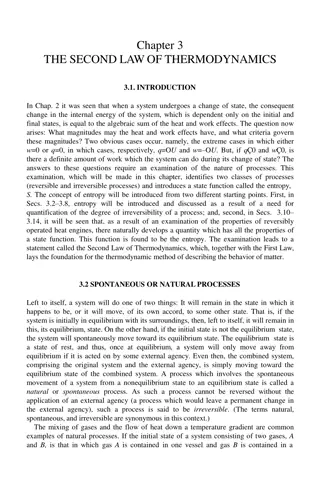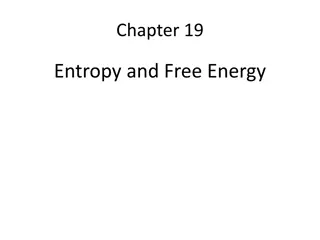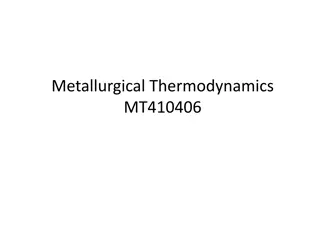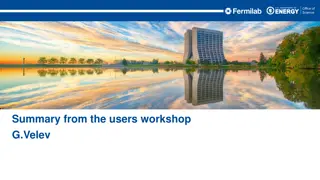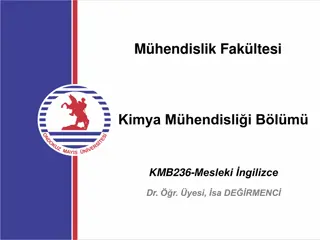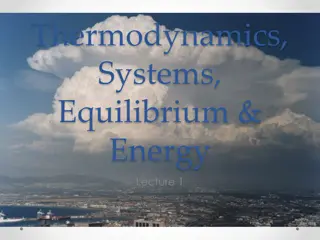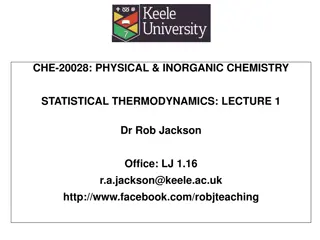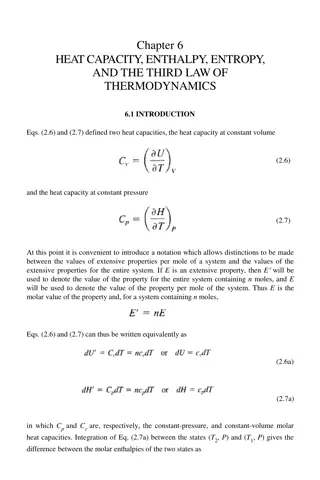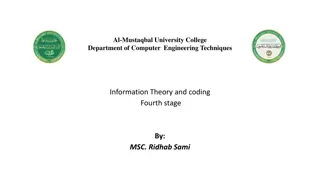Entropy and the Second Law of Thermodynamics
The concept of entropy and the Second Law of Thermodynamics are fundamental principles in thermodynamics. Entropy is a measure of disorder or randomness in a system, with entropy production being a result of irreversibilities. The Second Law of Thermodynamics states that entropy in a closed system tends to increase over time. This principle can be understood through the balance and transport of entropy within and across system boundaries. The integration of heat transfer and entropy change in different processes provides a deeper insight into the behavior of systems in thermodynamic processes.
Download Presentation

Please find below an Image/Link to download the presentation.
The content on the website is provided AS IS for your information and personal use only. It may not be sold, licensed, or shared on other websites without obtaining consent from the author.If you encounter any issues during the download, it is possible that the publisher has removed the file from their server.
You are allowed to download the files provided on this website for personal or commercial use, subject to the condition that they are used lawfully. All files are the property of their respective owners.
The content on the website is provided AS IS for your information and personal use only. It may not be sold, licensed, or shared on other websites without obtaining consent from the author.
E N D
Presentation Transcript
Department of Mechanical Engineering ME 322 Mechanical Engineering Thermodynamics Lecture 20 Entropy Balance Equation
The Second Law of Thermodynamics Entropy is a balanced quantity. Therefore, Entropy produced within a system Entropy transported into a system Entropy transported out of a system Entropy gained within a system + = T S S S P G + = S S S Total Entropy Form T P G + = Entropy Rate Form S S S T P G Something to think about ... We have already seen that entropy production occurs due to irreversibility. But, how is entropy transported across a system boundary? 2
The Second Law of Thermodynamics First, consider a closed system. For this system, we know that the Second Law is, Q W + = + = S S S dS dS dS T P G T P G Recall that Clausius discovered entropy analyzing a Carnot cycle as a closed system. His discovery was, T H E dQ T = dS rev T in this expression is the boundary temperature where Q is being transferred. L T 3
The Second Law of Thermodynamics For a reversible process, we know that the entropy production is zero. Therefore, for a reversible process, the Second Law says, Q W = dS dS T G dQ T = dS Now, consider Clausius discovery again, rev For the closed system that we are analyzing, it is clear that heat and work cross the system boundary. Therefore, we can say that, dQ dS T = = and dS dS T G sys rev 4
The Second Law of Thermodynamics We have just discovered that that the entropy is transported into the system by heat, but NOT by work! Q W For any closed system process, we can write, + dQ T = dS dS P sys This expression can now be integrated between any two states, + 2 2 2 dQ T = dS dS P sys 1 1 1 5
The Second Law of Thermodynamics Analyzing each integral ... + 2 2 2 dQ T = dS dS P sys 1 1 1 = Q T 2 dQ T Assumption: The system boundary is isothermal. The summation sign accounts for all heat transfer. k 1 k k 2 ( ) = = dS S S m s s The entropy change inside the system. 2 1 2 1 sys 1 This is the integral of the entropy production in an irreversible process. But ... how do we evaluate the integral??? 2 dS = ??? P 1 6
The Second Law of Thermodynamics Entropy production is caused by irreversibilities. Consider two piston-cylinder assemblies. They are identical in every way except that one of them operates reversibly and the other is irreversible. Questions ... 1. Which system has zero entropy production? Which system delivers more work? Is work a property? Is entropy production a property? Didn t the Kelvin-Planck Statement say what was on the left was impossible? W W irr rev 2. Q 3. 4. 5. Q reversible irreversible 7
The Second Law of Thermodynamics Entropy IS a property (specific entropy is an intensive property) Entropy Production IS NOT a property. It is a path function, just like heat and work! + dQ T = dS dS P sys Now, we can integrate the entropy production term! > 0 means that the process is irreversible = 0 means the process is reversible < 0 means the process is impossible 2 = dS S ,12 P P 1 8
The Second Law of Thermodynamics For a Closed System, the Second Law of Thermodynamics can be written as, + = S S S T P G Q T ( ) + = k S m s s ,12 2 1 P k k This can be written on a per unit mass basis by dividing both sides of the equation by the mass of the system, ( ) ( 2 k k T m S / Q m q T ) + = ,12 + = P k s s k s s s 1 ,12 2 1 P k k 9
The Second Law of Thermodynamics Incorporating the net entropy transport into the system due to the mass flows gives the complete form of the Second Law of Thermodynamics! dS Q T sys + + = k ms m s S i i e e P dt k i e k Notice that if the system is closed, dS Q T sys + = k S Rate Form P dt k k Q T ( ) + = k S m s s Total Form ,12 2 1 P k k 10
The Laws of the Universe Conservation of Mass The Continuity Equation dm dt sys = m m i e i e Conservation of Energy The First Law of Thermodynamics dE dt 2 2 V V g g g g sys Q W + + + + + = i e g m h z m h z i i i e e e 2 2 g i e c c c c The Entropy Balance The Second Law of Thermodynamics dS Q T sys + + = k ms m s S i i e e P dt k i e k 11
Special Application Closed Systems Consider a closed system that is reversible and adiabatic. The second law for such a system is, 0 0 Q T ( ) + = k S m s s ,12 2 1 P k k ( ) = = 0 s s s s 2 1 2 1 We have just learned that a reversible and adiabatic process for a closed system is isentropic! Notice: Reversible does not mean isentropic Adiabatic does not mean isentropic Reversible and adiabatic means isentropic! 12
Special Application Open Systems Consider an open system that is operating in steady state and is reversible and adiabatic with one flow in and one flow out. The second law for such a system is, 0 0 0 dS Q T sys + + = k ms m s S i i e e P dt k i e k ( ) = = 0 m s s s s i e i e We have just showed that a reversible and adiabatic are the conditions for isentropic for either open or closed systems. 13
Ideal Gases w/constant cp We previously derived the following expressions for an ideal gas from the Gibbs Equations, v v P P dT T dT T T T 2 2 = + = ln ln s s c R s s c R 2 2 2 1 2 1 v p T T 1 1 1 1 If the gas is undergoing a process where the heat capacity can be assumed to be constant, T T P P = ln ln s s c R 2 2 2 1 p 1 1 Consider a case where the process is also isentropic. Then, T T P P = ln ln 0 c R 2 2 p 1 1 14
Ideal Gases w/constant cp Algebra time ... T T P P T T P P R c T T P P = = = ln ln 0 ln ln c R 2 2 2 2 ln ln c 2 R 2 p p 1 1 1 1 p 1 1 R c T T P P p = 2 2 1 1 Rearrange the exponent, ( ) ( / p ) / / c c c c c c c c R c 1 k p v c v v = p v p = = k ( ) c c k p p v v 15
Ideal Gases w/constant cp 1 k T T P P k = Substitution gives, 2 2 1 1 Using the other Gibbs equation for an isentropic process 1 k T T v v T T v v = = + = 0 ln ln s s c R 2 2 2 2 2 1 v 1 1 1 1 Therefore, for an ideal gas with constant heat capacity undergoing an isentropic process, 1 k 1 k T T P P v v k = = 2 2 2 1 1 1 16
Ideal Gases w/constant cp But wait ... there s more!! 1 1 k k 1 1 k k T T P P v v P P v v k k = = = 2 2 2 2 2 1 1 1 1 1 Rearranging ... 1 1 k k = 1 1 1 2 k k P v P v k k 2 1 1 1 k k = 1 1 k k P v P v k k 2 2 1 1 k k ( ) ( ) 1 1 k k = 1 1 k k 2 2 Pv 1 1 Pv = k k 2 2 Pv 1 1 Pv Does this look familiar? 17
Polytropic Process Relations Pv = n constant 1/ n n P P v v v v P P Any fluid model (P-v relationship) = = 2 1 2 1 1 2 1 2 ( ) 1 / 1 n n n T T v v T T P P Ideal Gas Model (P-v-T relationship) = = 2 2 2 2 1 1 1 1 ( ) 1 / 1 k k k Ideal Gas Model Isentropic process, constant heat capacity T T v v T T P P = = 2 2 2 2 1 1 1 1 Important Polytropic Exponents = = / (ideal gas with constant heat capacity - isentropic process) v c c 0 (isobaric) n k p n = n = n = (isochoric) 1 (ideal gas, isothermal) 18
